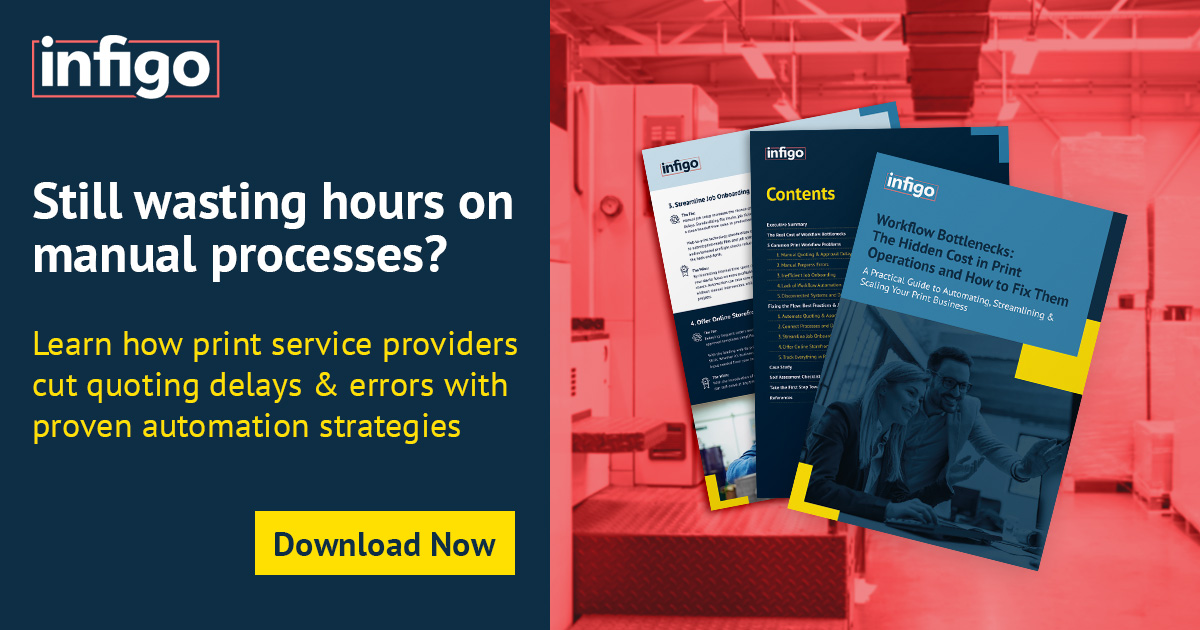When business success is dependent on providing printing precision, while meeting strict deadlines, small inefficiencies add up. From chasing orders via email to fixing artwork at the eleventh hour, many print shops find themselves stuck in reactive, manual processes–Which may already feel eerily familiar to your print business.
Over time, these slowdowns and bottlenecks erode profitability, drain resources, and damage customer trust.
However, innovative web-to-print platforms are increasingly rising to the challenge–providing a seamless, enjoyable experience for customers, which in turn increases repeat business and revenue.
Meanwhile, in the backend, data syncing across your work processes automates costly manual systems.
The fact is, the best web-to-print platforms don’t just digitize your processes—they transform them. They connect every part of the customer journey and production workflow into a single, seamless system. The result? Your print business runs smoother, faster, and more profitably.
Read on to discover how industry-leading platforms are turning outdated workflows into something that feels, quite honestly, magical.
1. Taking Sales Online with a 24/7 Storefront
Before: Disjointed, Manual Sales
Orders come in via email, phone, or clunky forms. Sales teams spend time chasing missing details, creating manual quotes, and rekeying job specs into spreadsheets. The result? Slow responses, inconsistent pricing, and frustrated customers.
After: Always-On, Self-Service Ordering
With a fully branded storefront, customers can place orders at any time—whether it’s 2PM or 2AM. They can upload artwork, view live pricing, approve proofs, and make payment without needing to pick up the phone.
Everything is streamlined, logged, and ready for production.
Customers get a smoother experience. Your sales team gets their time back. And your business can process more orders without adding more staff.
2. Reducing Revision Cycles with Built-in Editing Tools
Before: Endless Amends and Artwork Delays
Small changes—like a misspelled name or a logo update—require back-and-forth emails, internal design time, and manual proofing. It slows production and increases the chance of errors slipping through.
After: Live, On-Demand Personalization
The most innovative web-to-print platforms come with in-browser editing tools that let customers make changes themselves. Whether it’s adding names to business cards or updating content on flyers, personalization is quick, intuitive, and controlled.
Templates can lock key brand elements (such as fonts or colors), so consistency is guaranteed. Once complete, the file is ready for print—no need to involve a designer or pre-press operator.
This doesn’t just save time. It improves accuracy and gives customers a stronger sense of control over their order.
3. Syncing Every System Across the Workflow
Before: Data Silos and Double Entry
When your MIS, CRM, production software, and fulfillment tools don’t talk to each other, things get messy. Orders have to be entered into multiple systems. Job statuses are unclear. And human error becomes a regular—and costly—issue.
After: Seamless Integration Across Platforms
The best web-to-print platforms are built for connectivity. They integrate with the tools you already use—whether that’s your MIS, accounting software, inventory system, or courier API.
Job data flows automatically from order to output. Status updates are visible in real time. Every department sees the same information—without needing to ask for it.
As a result, research shows that integrated workflows can reduce job processing time by up to 70%.
When systems connect, communication improves, errors drop, and everything just works better.
4. Automating Pre-Press Checks and Batching for Efficiency
Before: Manual Checks and One-at-a-Time Printing
Each incoming file is inspected manually. Pre-press staff flag issues like missing bleed, low-res images, or incorrect color modes—and chase the customer for a fix. Meanwhile, similar jobs are processed individually, wasting time and materials.
After: Smart Preflighting and Production Batching
Leading platforms now offer automated preflight checks during file upload. Customers are alerted to issues before they complete their order—saving time on both sides.
Even better, jobs can be grouped and batched automatically by substrate, finish, or press type—so presses run longer with fewer stops and setups.
It’s a major win for production efficiency, and it adds up quickly in time saved, waste reduced, and jobs delivered on schedule.
5. The Result: A Business That Runs Like Clockwork
Put all these changes together and the transformation is striking.
- Manual tasks are automated
- Human error is reduced
- Turnaround times improve
- Customers are happier
- Profitability increases
You no longer spend your day firefighting. Instead, your business is built on proactive systems and processes that scale—so you can grow without growing your headcount.
And while none of this is truly “magic,” it might feel that way when the 10am rush doesn’t send your production schedule spiraling out of control.
Don’t Let Manual Processes Hold You Back
Print businesses that embrace automation don’t just move faster—they operate smarter. And in today’s market, efficiency isn’t optional—it’s survival.
The good news? You don’t need to reinvent your entire operation overnight. You just need the right technology partner—and a clear roadmap to transformation.
Ready to bring your print shop into the future?
Learn how a modern web-to-print platform could revolutionize your workflows.
Download our free guide, Workflow Bottlenecks: The Hidden Cost in Print Operations and How to Fix Them.





